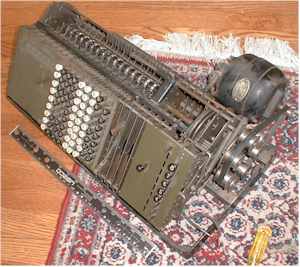| Ensign Calculator |
 |
"Introduction. This is a short note on the Ensign, an American four function calculator. The machine was designed and patented by E.S. Ensign shortly after the turn of the century, and was sold as late as perhaps 1920. I do not know anything about the actual history of the machine other than four patents, some advertisements and a short description in Ernst Martin's book (page 189). My Interest: It has been my hobby to search through US and British patent files in search of information on slide rules, calculators, adding machines and calculators. This is a good way of collecting basic information, given that patents are not really meant to educate the reader. At some point in time I obtained US patents 773,632 (Nov 1, 1904), 809,047 (Jan 2, 1906), 879,449 (Feb 18, 1908) and 889,668 (Jun 2, 1908), all issued to Emory S. Ensign of Newtonville, Mass. Collectively, they are about 0.4 inches thick - I admit to not really to have read them. They describe the machine in over-whelming detail. I have found two advertisements for it, one in 1910, and the other in 1913. These were both in the magazine SYSTEM. Found I have been looking for an example for my collection for some time. It is an elusive device. Finally, this year, one turned up. I saw it is a rather poor photograph and contacted the owner. It turned out to have no markings, but the shape was a giveaway. I bought it, and it took tome time to get here, as it is very heavy. With the cast iron case off , it still weighs about 70 pounds. It is not the greatest condition: I would rate it between a 4/4 and a 5/5 on the Breker scale. That is, in very poor condition: it is dirty, there are parts missing (especially key tops) and is rusty is many places. However, I think that it is restorable. Why Is This Machine Interesting Well, I do not know that it is to anyone else besides myself. However, a few specifications: * It is a full keyboard machine. Information I am hoping that someone will have a manual for it. If you do, please let me know." Robert Otnes, PhD |
Courtesy of: Robert Otnes, PhD |